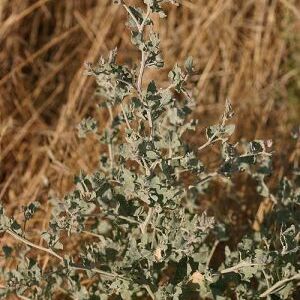Herbs, simple or freely branched, 0.5-6 dm; branches rather stout, angled, scurfy when young. Leaves often opposite proximally, petiolate or distal bracteate ones subsessile, blade lance-ovate, lanceolate, deltoid, or cordate, 5-75 × 4-50(-75) mm, base subhastate or obtuse to acute, margin entire or essentially so, sometimes closely repand-dentate, apex obtuse to acute or rounded, scurfy (glabrous). Flowers in axillary glomerules and terminal, interrupted spikes. Staminate flowers borne in distal axils, or in short dense spikes or panicles, or intermixed with pistillate, with 4-5-parted calyx. Fruiting bracteoles sessile, subsessile, or stipitate (stipe 0.5-5 mm), cuneate-orbicular, (2.5-)4-11.2 × 2-8.8 (-14 ) mm, margin foliaceous below apex, subentire or dentate to laciniate, face smooth, tuberculate, or crested, processes sometimes again toothed, teeth then aligned with axis of process. Seeds brown, 1.5-2 mm wide; radicle superior or lateral. 2n = 18, 36, 54.
More
Much-branched herb to 8 dm, silvery-scurfy throughout; lvs lanceolate to ovate or deltoid, 1–3 cm, often as wide, fls axillary and in terminal spikes, the staminate and pistillate mingled or separate; fruiting bracteoles cuneate-rotund, 4–7 mm long and wide, united to beyond the middle, irregularly toothed across the broadly rounded summit, the central part indurate, the tubercles few or none, to 2 mm; radicle superior; 2n=36. Widespread in dry or alkaline soils in w. U.S. and adj. Can., occasionally intr. e. to Mich., Mo., and reputedly O.
A small herb. It is erect and greyish green. It grows 15-80 cm tall. The leaves are sword shaped or triangle shaped.
Dry or moist, saline, fine-textured substrates, clay or silty alluvium, growing in salt desert shrub, valley bottoms and floodplain communities; at elevations from 1,200-2,100 metres.
More
It grows in open salty sites.

